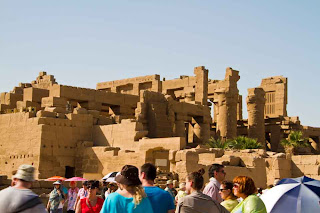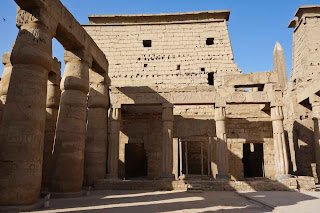After four days at sea and some great, active and very
full art classes, we arrived at Safaga, Egypt.
This is a relatively large port city, founded in about 275 B.C., on the
Red Sea at the base of an extensive mountain range.
 |
| Safaga Harbour |
On our first day in port, John went on a fourteen hour
tour leaving at 7:45 AM. The first part of the tour involved a three and a half
hour bus ride along the Egyptian version of a highway, very bumpy, partially
complete and very dusty. While it was
ostensibly a two-lane highway, there were many times when cars would pass,
forcing on-coming traffic to make its own path along the soft shoulders. In the
first hour of our ride we saw several Bedouin encampments, and lots of
mountains.
During the second hour we
entered the beginnings of the Sahara desert, still mountainous but very dry and
dusty. After three hours we finally got to cross the Nile River. This huge river provides all of Egypt with
its fresh water and all of its agriculture occurs within a few miles on either
side.
Half and hour later we arrived at the Valley of the Kings. Unfortunately, the local police would not
allow us to leave the bus with our cameras. The sights, however, were quite
impressive. This is the area where Pharaohs
were buried, hoping that grave-robbers would not find their remains.
After a
long walk uphill, we were taken to the tomb of Ramses IX who died about 1350 BC. The burial chamber is about 200 m inside the mountain. The downhill path is quite remarkable. The tunnel is about four metres square and
completely covered in pictures and hieroglyphics.
The second tomb was that of Ramses V. This was a warren of tunnels since along with
the Pharaoh were buried a number of other relatives and kings. What makes this
tomb unique is that it was discovered in 350 AD by the Romans. They used the tomb as a kind of hotel as they
travelled through the area. In 380 AD,
the tunnels were commandeered by early Christians. Because of this, the tomb contains some very
early graffiti, from Roman pictures over Egyptian pictographs to Christian
writings (in Latin), sketches of early monks with crosses drawn around them.
We were then taken by bus to the area of the Valley of
the Queens where there has been a recent discovery of many tombs of
wealthy nobles from some 3500 years ago.
There was a photo stop at the
Temple of Hatchepsut, the only female Pharaoh of that time. Her temple is a remarkable structure that is
three stories tall and was buried by sand for thousands of years. There are
also some very interesting ruins near the temple that are just now being
excavated.
 |
| John at Temple of Hatchepsut |
 |
| Ruins near Temple of Hatchepsut |
Our next stop was at the Colossi of Memnon, the only
remaining structures at the entrance to a temple that no longer exists. The birds really seem to love these
sculptures.
 |
| Collosi of Memnon |
We were then taken to the temple of Karnak, which is 65
acres in size and took almost a thousand years to complete. It is enormous in scope, and we only managed
to cover about ten acres of the property.
This involved a very long walk on a hot and dusty day. A good part of the temple, with construction
starting about 1350 BC, had a large roof supported by 109 pillars, each about
15 to 20 m in height. The ceiling, which no longer exists, was beautifully
painted. Another remarkable feature of this temple is that the entire 65 acre
site was surrounded by a mud-brick wall that was fifteen feet (about 5 m)
thick.
There was also a road connecting
Karnak to the Temple of Luxor that is one kilometre long containing 1000 sphinxes,
500 on each side of the road.
 |
| Part of the road from Karnak to Luxor |
Our last stop was at the Temple of Luxor. We were quite thankful that this temple was
much smaller than Karnak since we were all very tired at this point. This temple is very beautifully constructed,
again with a roof supported by many pillars, and many intricate carvings and sculptures.
This was the temple which Alexander the Great
captured in about 350 BC. He then added a wall of pictographs showing
himself as a god-like person in the Egyptian style. However, if you look at his depiction, you notice
the well-formed ears, musculature, knees and other special features that
Egyptian pictographs do not have. He also included a new god of fertility (look
closely at the pictograph) along with himself.
 |
| Alexander the Great with the god of fertility |
We were then taken to the Hotel St. George for
dinner. Here we had a lovely, hour long
meal along the Nile River.
From here we
left at 6:30 PM for the ride back to the ship arriving in Safaga at 10:15. A very long day indeed!














No comments:
Post a Comment